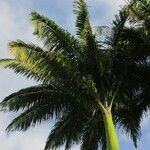Variable tree, usually not exceeding 25 m. in height, trunk not uniformly columnar but swollen at or near the middle and commonly at the base: leaves shorter and pinnae fewer in each line or row, with a brush-like look, pinnae 3-4 cm. broad: spadix branches not undulate: fruit long-globose to nearly globular, somewhat narrowed to base, 8-13 mm. long and approximately 10 mm. thick, red-brown or purplish at maturity.
Stems gray-white, 30 m, diam. 35--41 cm, smooth. Leaves: segments inserted on rachis in several ranks at divergent angles, giving leaf anappearing almost plumose appearance. Inflorescences to 1 m; rachillae 11--31 cm, stiff. Flowers white; anthers pinkish. Fruits ripening from green through red to purplish black at maturity, dorsiventrally compressed obovoid, 9.5--10.5 mm, diam. 7.4--7.8 mm. 2n = 36.


